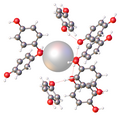Clathrate hydrate
Clathrate Hydrate is a type of crystalline water-based solid in which water molecules form a cage-like structure, known as a clathrate, trapping gas molecules within. These substances are notable for their unique structure, potential energy applications, and occurrence in natural environments such as ocean floors and permafrost regions. Clathrate hydrates are significant in various fields including geology, chemistry, and energy resources, due to their role in natural gas storage and transport, climate change, and potential as a future energy source.
Structure and Formation[edit]
Clathrate hydrates form under conditions of low temperature and high pressure, where water molecules create a lattice that encloses gas molecules. The structure of clathrate hydrates can be classified into several types, with Type I, Type II, and Type H being the most common. Each type has a distinct arrangement and size of the water molecule cages, determining which gas molecules can be trapped inside. Common gases found in clathrate hydrates include methane, carbon dioxide, and hydrogen sulfide.
Occurrence[edit]
Clathrate hydrates are found in nature in areas where the environmental conditions allow for their stability. These include the deep sea, beneath the ocean floor, and within the permafrost. In these environments, clathrate hydrates can form vast deposits, which are of significant interest for their potential as a source of natural gas.
Applications and Implications[edit]
The unique properties of clathrate hydrates have implications for energy storage and transportation. They offer a potential method for gas storage and transport, as they can contain a large volume of gas in a compact form. This has led to research into their use in natural gas extraction and transport, as well as in carbon capture and storage technologies.
However, clathrate hydrates also pose risks, particularly in relation to climate change. The release of methane, a potent greenhouse gas, from melting clathrate hydrates could significantly impact global warming. Understanding the stability and distribution of clathrate hydrates is therefore crucial in predicting and mitigating their effects on the climate.
Research and Challenges[edit]
Research into clathrate hydrates spans multiple disciplines, focusing on their formation, stability, and potential applications. Challenges include understanding their physical and chemical properties, developing efficient methods for their synthesis and decomposition, and assessing their environmental impact. The study of clathrate hydrates is also important for understanding geological processes and the history of Earth's climate.
See Also[edit]
References[edit]
<references/>
Clathrate_hydrate[edit]
-
Gas hydrate structure
-
Hydrate structures
-
Xenon paraquinol clathrate
Ad. Transform your life with W8MD's Budget GLP-1 injections from $75


W8MD offers a medical weight loss program to lose weight in Philadelphia. Our physician-supervised medical weight loss provides:
- Weight loss injections in NYC (generic and brand names):
- Zepbound / Mounjaro, Wegovy / Ozempic, Saxenda
- Most insurances accepted or discounted self-pay rates. We will obtain insurance prior authorizations if needed.
- Generic GLP1 weight loss injections from $75 for the starting dose.
- Also offer prescription weight loss medications including Phentermine, Qsymia, Diethylpropion, Contrave etc.
NYC weight loss doctor appointmentsNYC weight loss doctor appointments
Start your NYC weight loss journey today at our NYC medical weight loss and Philadelphia medical weight loss clinics.
- Call 718-946-5500 to lose weight in NYC or for medical weight loss in Philadelphia 215-676-2334.
- Tags:NYC medical weight loss, Philadelphia lose weight Zepbound NYC, Budget GLP1 weight loss injections, Wegovy Philadelphia, Wegovy NYC, Philadelphia medical weight loss, Brookly weight loss and Wegovy NYC
|
WikiMD's Wellness Encyclopedia |
| Let Food Be Thy Medicine Medicine Thy Food - Hippocrates |
Medical Disclaimer: WikiMD is not a substitute for professional medical advice. The information on WikiMD is provided as an information resource only, may be incorrect, outdated or misleading, and is not to be used or relied on for any diagnostic or treatment purposes. Please consult your health care provider before making any healthcare decisions or for guidance about a specific medical condition. WikiMD expressly disclaims responsibility, and shall have no liability, for any damages, loss, injury, or liability whatsoever suffered as a result of your reliance on the information contained in this site. By visiting this site you agree to the foregoing terms and conditions, which may from time to time be changed or supplemented by WikiMD. If you do not agree to the foregoing terms and conditions, you should not enter or use this site. See full disclaimer.
Credits:Most images are courtesy of Wikimedia commons, and templates, categories Wikipedia, licensed under CC BY SA or similar.
Translate this page: - East Asian
中文,
日本,
한국어,
South Asian
हिन्दी,
தமிழ்,
తెలుగు,
Urdu,
ಕನ್ನಡ,
Southeast Asian
Indonesian,
Vietnamese,
Thai,
မြန်မာဘာသာ,
বাংলা
European
español,
Deutsch,
français,
Greek,
português do Brasil,
polski,
română,
русский,
Nederlands,
norsk,
svenska,
suomi,
Italian
Middle Eastern & African
عربى,
Turkish,
Persian,
Hebrew,
Afrikaans,
isiZulu,
Kiswahili,
Other
Bulgarian,
Hungarian,
Czech,
Swedish,
മലയാളം,
मराठी,
ਪੰਜਾਬੀ,
ગુજરાતી,
Portuguese,
Ukrainian




